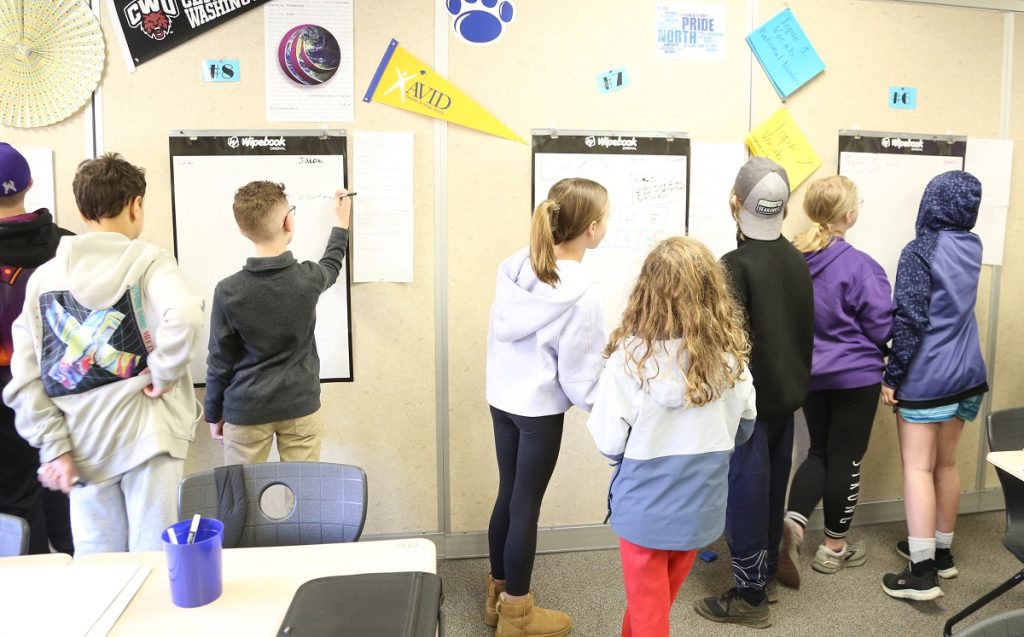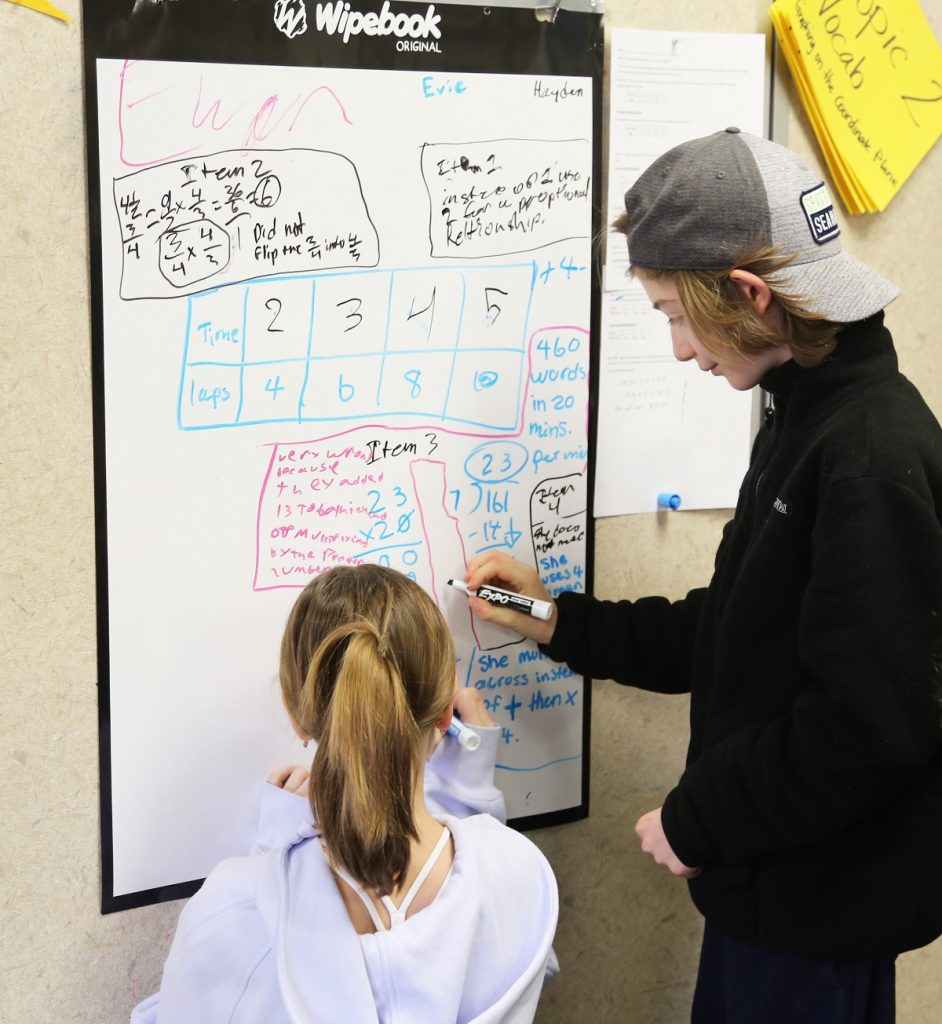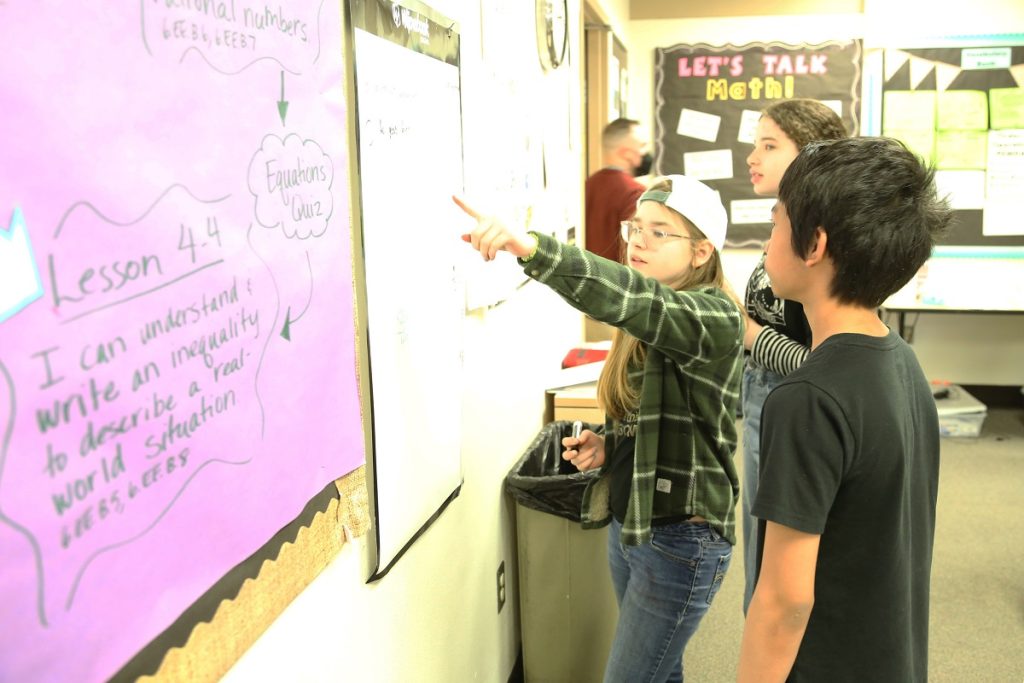Submitted by North Thurston Public Schools
Math classes can be among the most challenging subjects for students. Since 2018, select district staff and faculty at secondary schools across North Thurston Public Schools(NTPS) have worked together to implement a revolutionary teaching model in their math classrooms. The “Building Thinking Classrooms” method gets students out of their chairs and working together to solve curriculum-relevant problems or “thinking tasks,” all while building public speaking skills, social skills, and self-confidence.

A Thinking Classroom moves away from the traditional math classroom structure. Instead of a lecture followed by independent work on a set of problems (or a “now-you-try” model), teachers employing the Thinking Classroom method give an overview of the lesson’s objective in five minutes or less before breaking students into random groups of three. The groups gather around whiteboards and choose one student to be the scribe. Teachers then assign a series of thinking tasks verbally or they post sheets of problems beside the boards for each group to work through. The tasks start with a more basic problem and progress in complexity so that the concept at hand is “thin sliced” and feels more manageable for students.
The Power of Knowledge Mobility
Regardless of how the problems are presented, students are encouraged to work together inside and outside of their groups to solve them. “A huge focus of this practice is knowledge mobility,” says Linda Hicks-Green, an NTPS instructional specialist for secondary math. Hicks-Green discovered Building Thinking Classrooms at a 2018 conference and shared what she learned with colleagues in the district right away. Hicks-Green explains how powerful it can be for a student in one group to visit another group, learn a new way of thinking about or solving the problem at hand, and bring new knowledge or perspective back to their original group.
“Not only does such an experience boost a student’s confidence, but it helps them learn and remember the lesson in a way that goes far beyond the mimicry we so often see in math class because they have to understand it well enough to explain it to their peers,” she said.

New Territory for Teachers and Students
Teachers also behave differently in a Thinking Classroom. They move around the room and engage with multiple students at once, asking questions and offering encouragement. “Keep going,” Oksana Skillings says to groups of Algebra 1 students at River Ridge High School as she supports them through an exercise about exponents. They’ve been asked to come up with all the ways they can think of to multiply numbers so the result is 64. Some groups are writing down multiplication tables while others are drawing number trees. “It’s changed how I plan lessons,” Skillings said. “I like how this model lets me change my plans on the fly more easily if students aren’t getting something quickly, or if they master it more quickly than I expected.”
“I think this helps a lot with understanding how math works instead of just being told how it works,” said Korbin, a 9th-grader in Skillings’ class. “Understanding how and why something works definitely helps on a test because you’re able to apply it to more unique situations even if you weren’t necessarily taught that specific situation.”
Stacee Anderson, a special education teacher at River Ridge, implemented the Thinking Classroom approach in her math lessons during the 2022 fall term and has been thrilled with the outcome. “I love the collaboration that comes with this model and how successful it makes my students feel,” she said. “It makes my kids feel smart, and they don’t always feel that way. It’s a remarkable confidence booster.”
“This method is the embodiment of social emotional learning,” Hicks-Green said. Most classes have to push through a few lessons before the kids start to understand working cooperatively and publicly. “In classrooms where this is happening, a stronger community forms,” she said. “We see kids be nicer to each other and behave with more empathy.”

How NTPS Builds Thinking Classrooms
Hicks-Green provides a copy of “Building Thinking Classrooms in Mathematics, Grades K-12: 14 Teaching Practices for Enhancing Learning” by Peter Liljedahl to any math teacher in the district who is interested in adopting the method. She also helps them secure the whiteboards that need to hang in the classroom for the small groups to work publicly, as the method prescribes. A grant from the North Thurston Education Foundation made the purchase of whiteboards possible in all of the classrooms using this method so far. Students in Thinking Classrooms usually engage with the model one to two days per week. They still work in the same textbook as students in other classes, and they still receive homework, take quizzes and tests, and are held to the same state testing standards as their peers.
The implementation of the Building Thinking Classrooms method directly supports several outcomes in the NTPS Strategic Plan. It creates increased opportunities for students to use their voice (goal 2, outcome c) and supports students learning to collaboratively engage to solve problems (goal 3, outcome b). This approach to math instruction supports the district’s focus on social emotional learning, strengthens presentation and public speaking skills, encourages teamwork, and builds problem solving skills. NTPS is excited to broaden this offering so more students can enjoy the benefits of collaborative, physically engaged learning.
Sponsored




















































